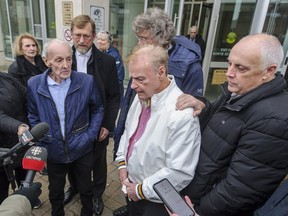Robert Mailman, 76, spent 18 years in jail, whereas Walter Gillespie, 80, served 21 years. On Thursday, the province’s chief justice discovered them harmless of a 1983 homicide.

Article content material
The story behind two New Brunswick males’s wrongful convictions for homicide comprises basic parts of how issues can go terribly mistaken in Canada’s justice system, say the attorneys who fought to show their innocence.
A written submission introduced to the courtroom by Innocence Canada attorneys on Thursday argues “police tunnel imaginative and prescient, the non-disclosure of vital proof, recantations by the 2 key Crown witnesses,” in addition to a disregard for the lads’s robust alibis, had been key elements in Robert Mailman and Walter Gillespie’s 1984 homicide convictions.
Commercial 2
Article content material
Article content material
Mailman, 76, spent 18 years in jail, whereas Gillespie, 80, served 21 years. On Thursday, the province’s chief justice discovered them harmless, following the federal justice minister’s Dec. 22 choice to overturn the 1984 convictions for second-degree homicide.
The courtroom doc goes again to Nov. 30, 1983, when George Leeman’s partially burnt physique was discovered by a jogger in a wooded space within the Fisher Lakes space in Saint John, N.B. There have been 20 blunt pressure wounds to his head and face, and a hospital pathologist concluded he had been useless for no less than 24 hours.
The investigation was stalled till Jan. 18, 1984, when a 16-year-old named John Loeman Jr. signed a press release — handwritten by police — that he had seen Mailman hanging Leeman on the pinnacle with the barrel of a shotgun on the night earlier than the physique was discovered. The witness claimed to have been about 5 or 6 metres away, hiding within the woods.
In response to the abstract, Loeman mentioned Gillespie was close by, holding “a white bucket with a golden liquid in it,” and he additionally noticed a lady, Janet Shatford, hit Leeman with an axe.
Shatford, who was arrested on Jan. 19, 1984, pleaded responsible to a diminished cost of manslaughter and in trade agreed to testify for the Crown towards Mailman and Gillespie, the doc says.
Article content material
Commercial 3
Article content material
It says she testified she had identified Leeman for a number of years and on Nov. 29 she encountered Gillespie and Leeman in a 1972 Buick that belonged to Marjorie Mills, Gillespie’s girlfriend.
She initially testified Leeman was discussing how he would provide you with cash to repay his money owed, and ‚ after Leeman and Mailman received out of the automotive — she witnessed Mailman hitting Leeman on the pinnacle with the butt of a shotgun and he informed her to strike Leeman with an axe.
Nonetheless, in its temporary, Innocence Canada outlines severe issues with these witnesses. The group’s attorneys additionally describe how Mailman and Gillespie had robust alibis police and the Crown wouldn’t settle for — an issue Innocence Canada says has been famous in 4 public inquiries into earlier wrongful convictions.
Each males had testified on the time they had been alleged to have dedicated the homicide, they had been repairing Marjorie Mills’s Buick. They mentioned when Loeman alleged they had been attacking Leeman, they had been truly on the best way to choose up a component to repair the windshield wiper. Mills corroborated the story, and a receipt was positioned to a store the place a automotive half was bought on Nov. 29, says the courtroom doc.
Commercial 4
Article content material
Innocence Canada’s submission says after Gillespie and Mailman’s first trial, which resulted in a hung jury, police investigated the alibi. It notes, “unknown to the defence,” the Saint John police confirmed a latest restore of the windshield wiper on the automotive.
Nonetheless, the Crown urged the jury within the second trial to search out the alibi was a fabrication “regardless of the ample proof on the contrary,” says the doc.
Then there have been the recantations of the 2 key witnesses. Innocence Canada famous it occurred 5 instances within the case of Loeman: to his personal lawyer, to a journalist, in two letters and to a federal Justice Division lawyer wanting into Mailman and Gillespie’s wrongful conviction case in 1998.
“He (Loeman) mentioned that he had given false proof in courtroom and was coerced to do that by Inspector Al Martin and Deputy Chief Charlie Breen of the Saint John Police,” mentioned the temporary. In his first assertion to police in December 1983, which was by no means disclosed to the defence, Loeman had mentioned the final time he noticed the sufferer was a couple of week earlier than the killing.
The Saint John Police mentioned in an electronic mail they’re declining touch upon the case as they wait to obtain a duplicate of the federal Division of Justice’s overview of the case and rationale that led to the ordering of a brand new trial and the acquittals of Mailman and Gillespie.
Commercial 5
Article content material
The Innocence Canada temporary additionally says for the reason that convictions, Mailman and Gillespie realized Saint John police had supplied a complete of $1,800 to Loeman, along with resort and relocation prices, and this wasn’t disclosed in the course of the trial.
“For a 16-year-old residing in poverty in 1984 this was some huge cash by any commonplace,” says the temporary, which argues this data ought to have been made out there to the defence in the course of the trial — permitting them to problem Loeman’s motives in testifying.
The Innocence Canada affidavit argues in coping with recanting witnesses like Loeman and Shatford, “it turns into unimaginable to find out when they’re telling the reality and when they’re mendacity,” and that with out corroboration, police and the Crown ought to have rejected their accounts.
Article content material
